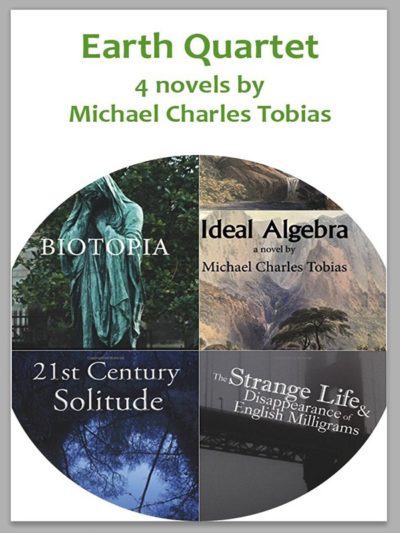Not unlike the famed four novel series by Lawrence Durrell — Justine (1957), Balthazar (1958), Mountolive (1958) and Clea (1960), Michael Charles Tobias’ perennially mind-bending Earth Quartet places several intertwined themes under a progressive microscope: Despair and suicide; solitude and the search for paradise; love in an epoch of extinctions (the Anthropogenic); numerous and harrowing ecological futures. In four searing, heart-pounding novels, all originally published by Zorba Press and written between 2011 and 2017, Tobias utterly demolishes every conceivable comfort zone, breaking bonds with predictable resolutions, laws, theories and hypotheses, and enshrining a singular ecological denouement that is at the heart of a universally emotional asymptote.
Like T. S. Eliot’s Four Quartets (also written during a six-year period and published during the darkest hours of World War II) Earth Quartet focuses upon a fast declining humanity that is only spared utter ruination by a mere inch, a fragile measure which — in Tobias’ most poignant literary and philosophical sculpting of the complex materials — becomes the ambassador of all liberation, both psychologically and materially.
The Strange Life & Disappearance of English Milligrams (2011), 21st Century Solitude (2013), Biotopia (2013) and Ideal Algebra (2017) together comprise a uniquely discordant and exhilarating immersion into characters whose every motive hinges upon a life force trapped by ever narrowing confines of a doomed biosphere. The circumstances, causes and consequences embroidering these dazzling tales are shockingly clinical and analytically credible. The world as we had always perceived it is disappearing; the only bonds worth struggling to retain are those most delicate of all: the sinews and nuances of compassionate resignation at every nadir of biological existence. If hope can be edified, taken as a literal evolutionary goal, then Tobias’ constellation of contagiously perplexing characters are the many torchbearers of its self-doubting apotheosis.

This new edition of the Earth Quartet strikes of a fascinating literary and ecological event. Rising from an obscurity that has been the hallmark of Tobias’ self-imposed literary distance from his contemporaries, the combining together of these four novels into a unified whole, with a new Introduction by the Author, is reminiscent of the Ukrainian edition of George Orwell’s Animal Farm (“Kolghosp Tvaryn”) and “intended for Ukrainians living in the camps for Displaced Persons in Germany under British and American administration after World War II,” with an original Preface in English by Orwell. In those pages Orwell explained, “I proceeded to analyze Marx’s theory from the animals’ point of view. To them it was clear that the concept of class struggle between humans was pure illusion, since whenever it was necessary to exploit animals, all humans united against them…” (* Prometej Publishers, 1947).
Tobias has written four related works that are each a hybrid of fiction and non-fiction, and oriented towards an audience which, in Samuel Beckett’s words are “lost ones.” A world of dislocated eyes and ears, of environmental refugees sweeping the planet, easily persuaded by the politics of mob behavior to kill themselves and all others. Tobias’ mesmerizing characters transcend that primeval pre-Socratic futility of the one versus the many by any number of ingenious means. In Tobias’ universe, survival is a metaphysical concept divorced from any Darwinian epithets or underpinnings. All sustenance, the dream of any future rests upon an expeditionary solitude that has acknowledged the drifting apart of humans — like a vast iceberg coming unhinged — from the mainland continental biodiversity that is forever receding from our view, even as its steadfast aboriginal origins continue to exert the ties of neurological and spiritual interdependency that have always been the hallmark of biological integrity here on Earth.
This tragedy of patent disassociations is the context for, and the pivot upon which Earth Quartet’s victims seek their existential, ecological release from the pain of seeing what is to become of all that was.
Throughout each of the four novels, the driving force is the desire to ameliorate one’s suffering and, by inference, all suffering. In seeking specific inoculations against a continuance of that world too much with us, wretched, ill-fated protagonists find that the more they are ready to acquiesce to the end, the more they see great beauty in it, feeling overwhelmingly that they must not give up. The shipwrecks of these myriad revelations include most notably the site of a solitary revelation on a farthest-most beach somewhere upon a West African island; a park bench beneath a windmill; the discovery of a floating body — that of a teenage girl, still breathing, in a Georgia swamp; a remote outcrop above a waterfall in late 21st century Scotland; and an unexplored cave, teeming with life, on Rapa Nui (Easter Island). Such settings define the trajectory from self-annihilation to re-enchantment with the world.
In every near sacrifice and self-destruction is the recognition that life nurtures that quality of understanding which is the essence of mercy, of kindness to oneself, of the unstinting acknowledgment that the world is beautiful still, and worth living for.
This review was first published by BookLovers Review, which is produced by Zorba Media, and edited by Michael Pastore. For more information about the books please visit the Zorba Press website.
The MAHB Blog is a venture of the Millennium Alliance for Humanity and the Biosphere. Questions should be directed to joan@mahbonline.org
MAHB Blog: mahb.stanford.edu/blog/earth-quartet/
The views and opinions expressed through the MAHB Website are those of the contributing authors and do not necessarily reflect an official position of the MAHB. The MAHB aims to share a range of perspectives and welcomes the discussions that they prompt.
